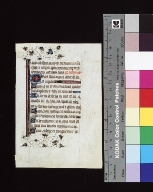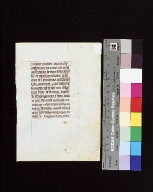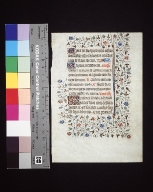|
REFINE
Browse All : Books of hours - Illustrations and Manuscripts, Medieval from 1450 approximate
1-4 of 4
Title
Horae Beatae Mariae Virginis: fragment
Creator
Catholic Church
Summary
[Ms. This manuscript leaf is part of a collection of medieval manuscript leaves selected to illustrate the art of the manuscript during the period of its greatest development and influence. They have been taken from books written in various European scriptoria by Benedictine, Franciscan, Carthusian, Dominican, and other orders of monks. Many are enriched with handsome borders, initial letters, and line-endings rendered in color. Twenty-five are illuminated with burnished gold or silver. The texts include the Bible, various church service books, the writings of the Church fathers, and some of the Classics., In angular gothic script, This Book of Hours shows definite characteristics of the manuscript art of France and the Netherlands of about 1450 A.D. It was probably one of many copies prepared for sale at a shrine to which devout pilgrims came to worship or to seek a cure. The spiked letters and the detached ornamental bar are unmistakably Flemish in spirit, while the free ivy sprays are distinctively French. The burnished metal in the decorations shows the use of alloyed gold (oro di metà) as well as silver. Various metals were added in different localities to the fine gold. English illuminations frequently had a decided orange hue, while the French had a lemon cast. The quality of the gold was best enhanced by the use of burnishing tools equipped with an emerald, a topaz, or a ruby. Less successful burnishers contained an agate or the tooth of a wolf, a horse, or a dog. This vellum leaf was created in Northern France.]
Title
Horae Beatae Mariae Virginis: fragment
Creator
Catholic Church
Summary
[Ms. This manuscript leaf is part of a collection of medieval manuscript leaves selected to illustrate the art of the manuscript during the period of its greatest development and influence. They have been taken from books written in various European scriptoria by Benedictine, Franciscan, Carthusian, Dominican, and other orders of monks. Many are enriched with handsome borders, initial letters, and line-endings rendered in color. Twenty-five are illuminated with burnished gold or silver. The texts include the Bible, various church service books, the writings of the Church fathers, and some of the Classics., In angular gothic script, It is generally no great task to assign these illuminated Books of Hours to a particular country or period. The treatment of the ivy spray with the single line stem and rather sparse foliage is characteristic of the work of the French monastic scribes about the year 1450 A.D. The occasional appearance of the strawberry indicates that the illuminating was done by a Benedictine monk. Fifty years earlier the stem would have been wider and colored, and the foliage rich; fifty years later the ivy and holly leaves would be entangled with flowers and acanthus foliage. This vellum leaf was created in France.]
Title
Horae Beatae Mariae Virginis: fragment
Creator
Catholic Church
Summary
[Ms. This manuscript leaf is part of a collection of medieval manuscript leaves selected to illustrate the art of the manuscript during the period of its greatest development and influence. They have been taken from books written in various European scriptoria by Benedictine, Franciscan, Carthusian, Dominican, and other orders of monks. Many are enriched with handsome borders, initial letters, and line-endings rendered in color. Twenty-five are illuminated with burnished gold or silver. The texts include the Bible, various church service books, the writings of the Church fathers, and some of the Classics., In angular gothic script, The text of a Book of Hours consists of Gospels of the Nativity, prayers for the Canonical Hours, the Penitential Psalms, the Litany, and other prayers. The beauty of the rich borders found in some of these books frequently claims our attention more than the text. In these borders it is easy to recognize the ivy leaf and the holly, but is usually more difficult to identify the daisy, thistle, cornbottle, and wild stock. The monks had no hesitancy in letting these flowers grow from a common stem. Because of the translucency of vellum, the flowers, stems, and leaves of the border were carefully superimposed on the reverse side in order to avoid a blurred effect. This vellum leaf was created in France.]
Title
Horae Beatae Mariae Virginis: fragment
Summary
[Ms. This manuscript leaf is part of a collection of medieval manuscript leaves selected to illustrate the art of the manuscript during the period of its greatest development and influence. They have been taken from books written in various European scriptoria by Benedictine, Franciscan, Carthusian, Dominican, and other orders of monks. Many are enriched with handsome borders, initial letters, and line-endings rendered in color. Twenty-five are illuminated with burnished gold or silver. The texts include the Bible, various church service books, the writings of the Church fathers, and some of the Classics., In angular gothic script, In the second half of the 15th century, the devout and wealthy laymen had a wide selection of Books of Hours from which to choose, both manuscript volumes and printed texts. These were often sold, in large cities, in book stalls erected directly in front of the main entrance to the cathedral. The first printed and illustrated Book of Hours appeared in 1486. It was a crude work, but later noted printers such as Verard, Du Pre, Pigouchet, and Kerver issued in great numbers Books of Hours with numerous illustrations and rich borders. The decorations were frequently hand colored and further embellished with touches of gold. These Books of Hours created a strong competition for the more costly manuscript copies. Customers who still preferred the manuscript format and could afford it also had a choice of many different types of decoration and could stipulate what quantity and quality of miniatures they desired. By this time the ivy spray had a variety of forms. It might be seen springing from an initial letter, from the end of a detached bar, in a separate panel in company with realistic flowers, or forming a three- or four-sided border intermixed with acanthus leaves and even birds, animals, and hybrid monsters which are neither man nor beast. This vellum leaf was created in France.]
1-4 of 4
|



